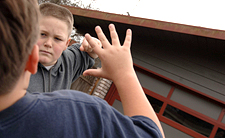“Some kids just get targeted—no question about it. These adolescent years are tough,” explains Byrne.

Once considered a harmless rite of passage, bullying is drawin more attention from parents and policy makers across the country in the wake of on-campus shootings in Arkansas, California, Colorado, Michigan, Minnesota, Mississippi and Washington. In many cases, the teen killers were identified as having, themselves, been longtime victims of bullying.
Though school shootings are quite rare, several psychological studies, including one conducted by the U.S. Department of Justice, have found that bullying commonly leads to psychological trauma, depression and truancy in students.
Three years ago, Sunnybrae Middle School began a study, determined to discover how much bullying was, in fact, going on and what administrators could do to reduce it. “Bullying will never just disappear,” explains Byrne, “but we can decrease its frequency. We can’t have some kid sitting there, just simmering and going through a lot of pain.”
The school, however, was faced with a challenge—how exactly would they go about measuring the severity of bullying on their campjus? Humboldt State psychology professor, William Reynolds, had the answer. Reynolds is an expert on teen depression and suicide. The research tools he developed to measure depression in adolescents have been used in 35 countries and cited in several hundred research publications. Five years ago, Reynolds turned his attention to school violence and developed scales that enable school administrators to determine the impact of bullying on their own campus.
The good news for Sunnybrae? For starters, the study found that there is less bullying at the school than is typical for its school its size. “Oh, the study’s been really helpful,” says Byrne. “Now we know where and how the bullying is happening and we’re addressing it. We’ve changed some of our rules, incorporated an anti-bullying element in our curriculum, and are teaching students conflict resolution and bystander skills. Kids who are victims or depressed are getting help they may not have gotten otherwise.”
Reynolds is happy knowing that his research is making a difference in children’s lives. “That’s really why I do what I do. Even though I’m not a clinical psychologist, I still have a need to help kids in distress and I try to do that through my research.